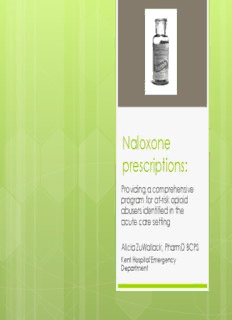
providing a rescue antidote and counseling to avoid PDF
Preview providing a rescue antidote and counseling to avoid
Naloxone prescriptions: Providing a comprehensive program for at-risk opioid abusers identified in the acute care setting Alicia ZuWallack, PharmD BCPS Kent Hospital Emergency Department Opioid overdose epidemic in RI Rhode Island is in the midst of a severe prescription and street-drug overdose crisis. There have been more than 70 opioid- related deaths since the start of 2014 in communities all over Rhode Island. Many of these deaths are directly related to the use of fentanyl and heroin. Press release, RI Dept of Health, 4/3/14 RI a national leader…in drug abuse In the top 5 states for illicit drug use In the top 12 for overdose deaths Overdose leading cause of accidental death, over MVAs Third highest state for illicit use of prescription drugs In 2013, 360,000 Rhode Islanders — more than one-third of the entire population — filled prescriptions for controlled substances. The Providence Journal, 2/8/14 Tightening up prescribing: the unintended consequence In 2013, 1400 Rhode Islanders obtained their controlled drugs from ≥ 5 prescribers and ≥ 5 pharmacies suggesting widespread abuse. Programs like the PMP and efforts from the DOH have attempted to regulate this type of behavior. Less access to RX opioids + ongoing addiction = use of street drugs Heroin can be snorted… Not a huge leap for prescription opioid abusers. Emergency Regulations “The Department [of Heath] finds that there is imminent peril to the public health, safety and welfare and that these emergency regulations should be adopted to protect the public health. Due to the sharp increase in overdose deaths in RI on 2014, expanded access to naloxone has become immediately necessary to save lives.” Rules and regulations pertaining to opioid overdose prevention [R23-1-OPIOID], RI DOH March 2014 Emergency Regulations One prescriber is now able to issue a non-patient- specific order to numerous organizations, such as police departments, allowing for increased access to naloxone. A prescription for naloxone may be prescribed to persons other than the individual who have the potential for overdosing on opioids. These regulations provide protections against any professional disciplinary action resulting from such prescribing. Rules and regulations pertaining to opioid overdose prevention [R23-1-OPIOID], RI DOH March 2014 Emergency Regulations A person who is not otherwise licensed to administer naloxone may in an emergency situation administer naloxone without fee if the person believes in good faith that an individual is experiencing drug overdose. A person who administers naloxone shall not be subject to civil liability or criminal prosecution as a result of administering the drug. Rules and regulations pertaining to opioid overdose prevention [R23-1-OPIOID], RI DOH March 2014 Some common questions: Is naloxone safe? Can we trust lay people to recognize overdose and give naloxone correctly? Will 911 really be called? Will people use more heroin because they know they have an antidote if they overdose? Will the drug abuser try to “override” the naloxone by shooting up with more heroin? Does it save lives, or is it just a theory? Is it worth it? Do these people ever stop using heroin or do they just live to overdose again? Is naloxone safe? Naloxone has no real intrinsic toxicity Research in spinal cord injury used enormous doses of 5.4mg/kg bolus then 4mg/kg/hr x 23 hrs without complication J Neurosurg 1992;76:23-31 Epi-Pen, another antidote we routinely prescribe, has much more intrinsic toxicity. Can we trust the lay public to give it correctly? Well, bystander CPR saves lives… Lay persons use AEDs to deliver 300 joules of electricity to the hearts of victims of cardiac arrest… Is it such a stretch for a lay person to administer a nasal spray to a victim of respiratory arrest?
Description: